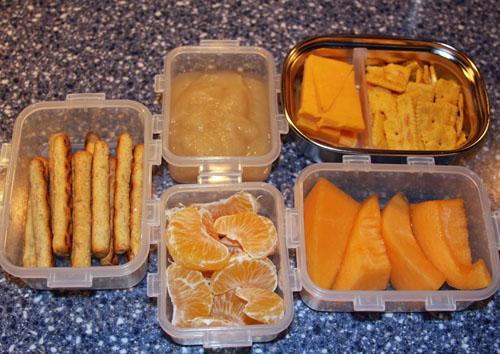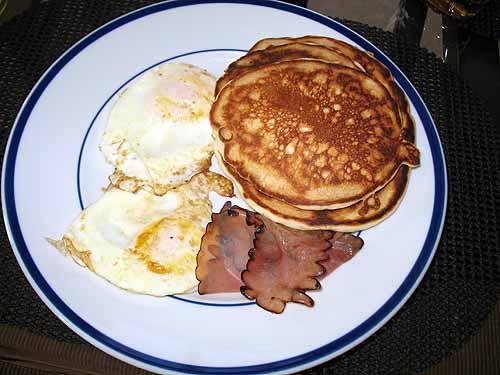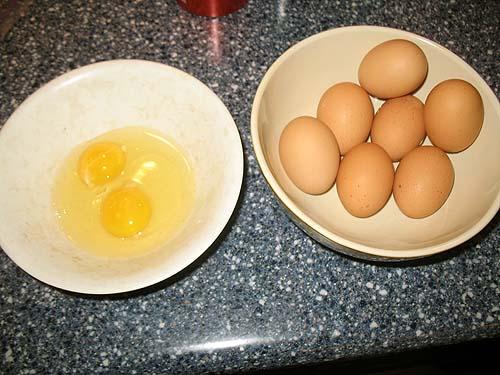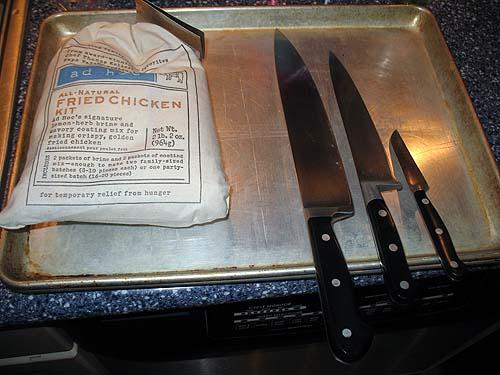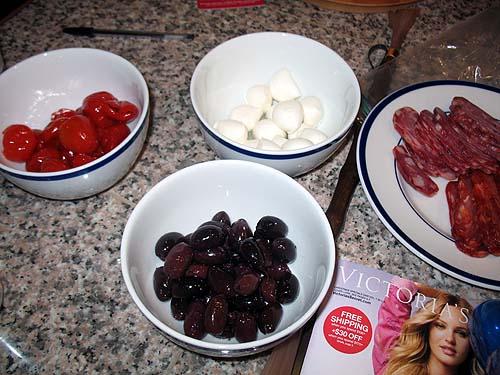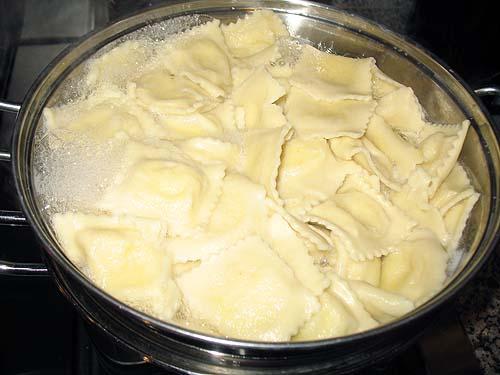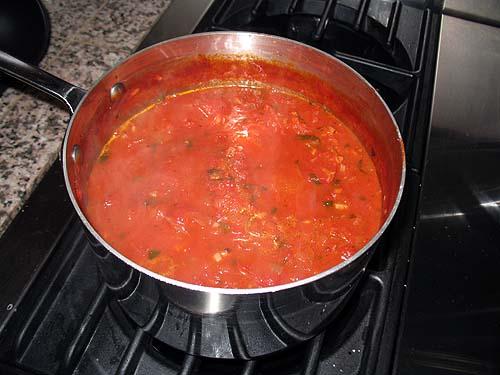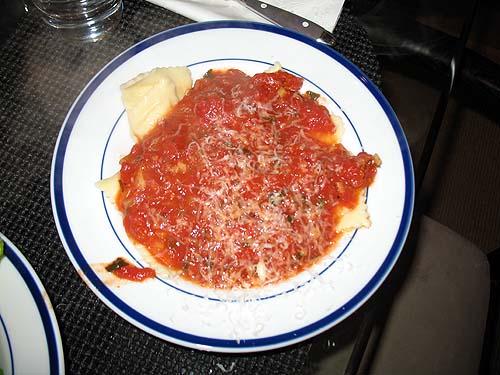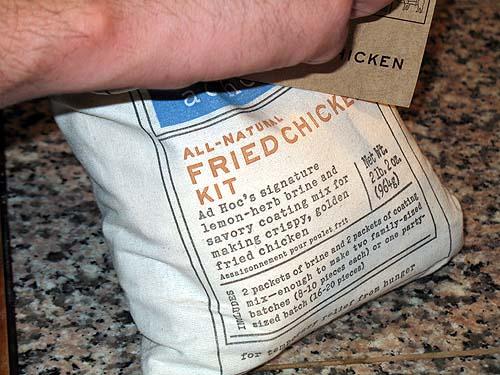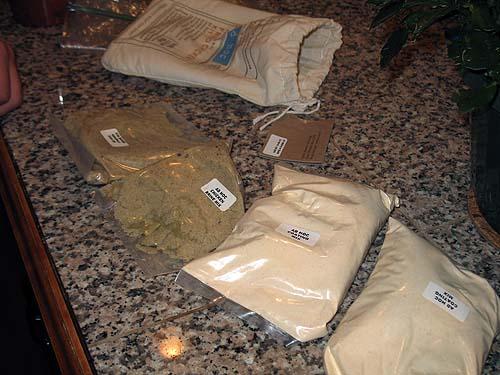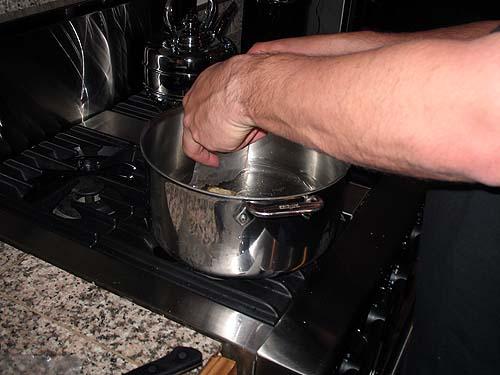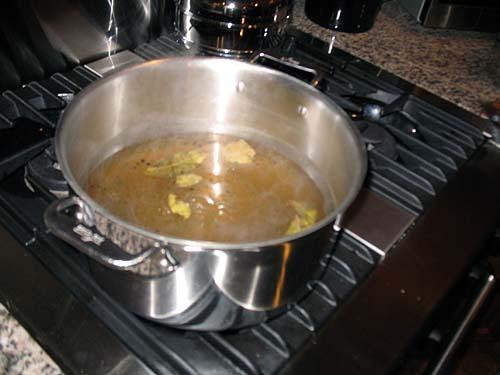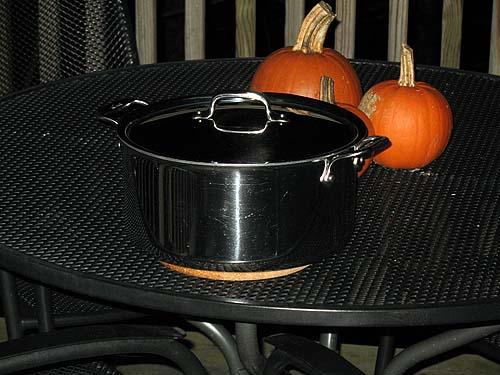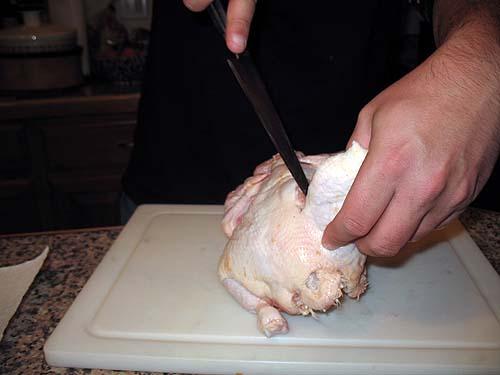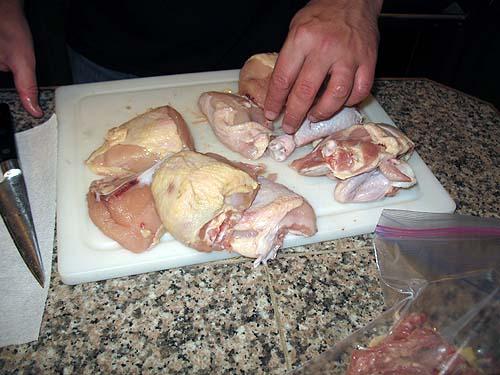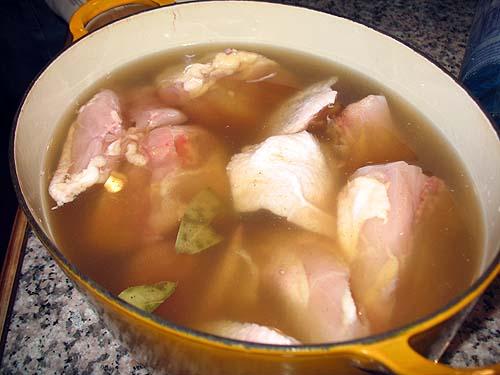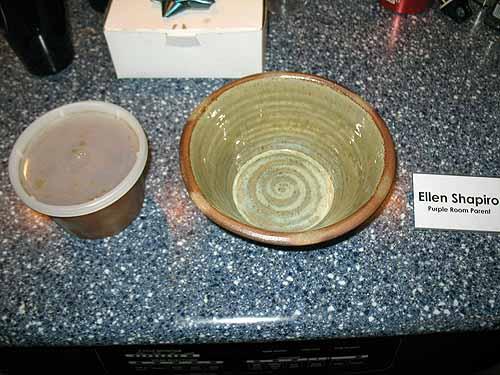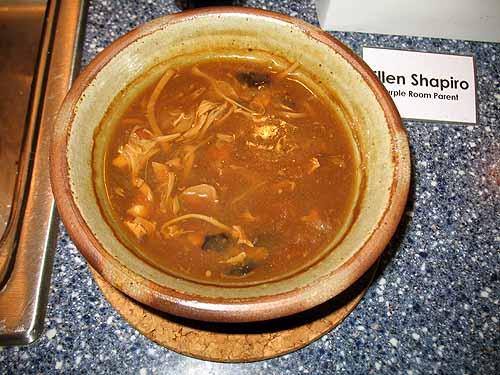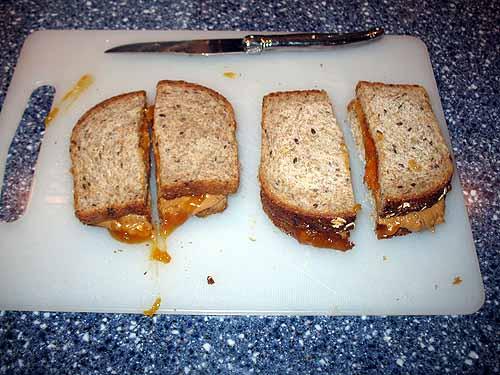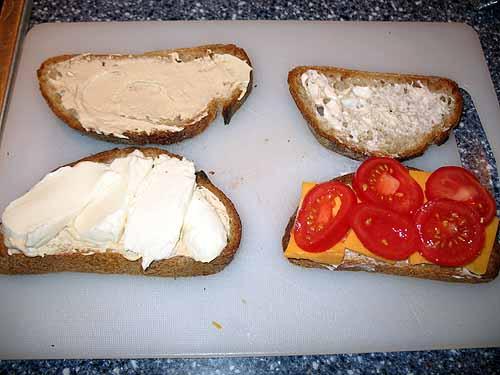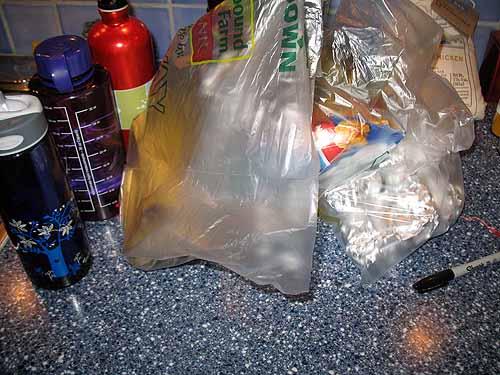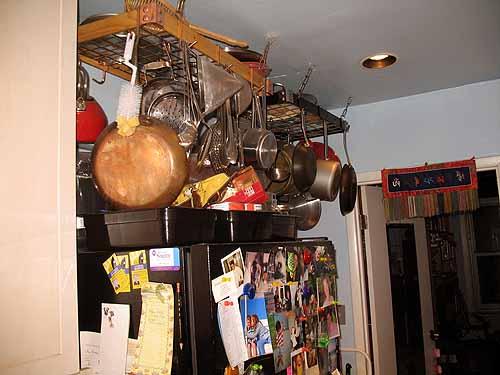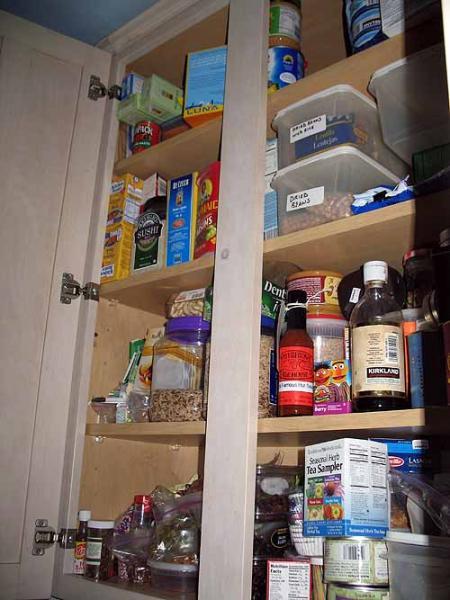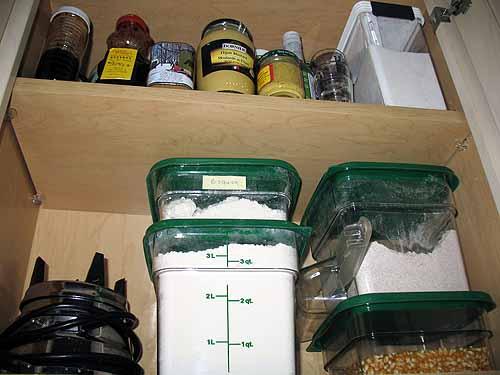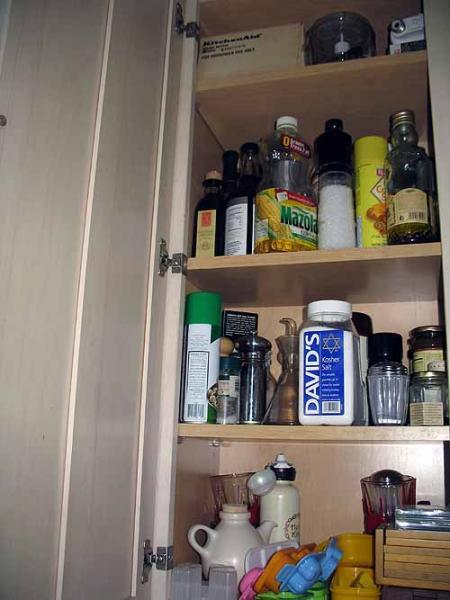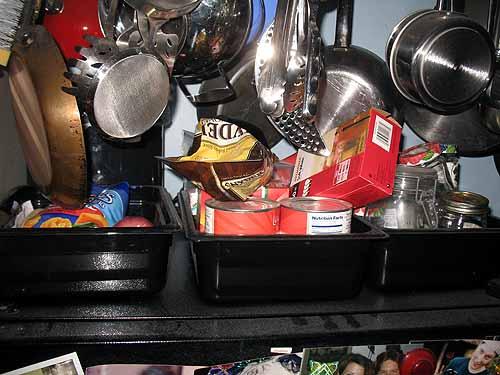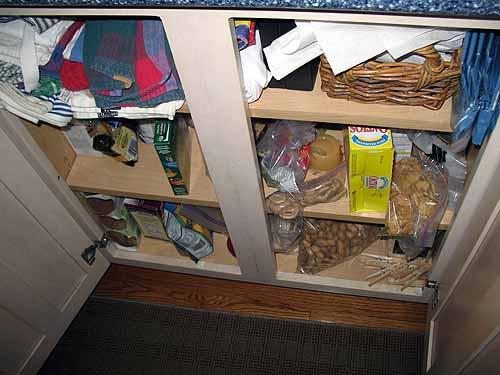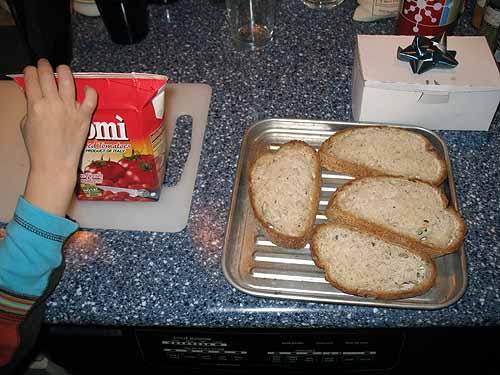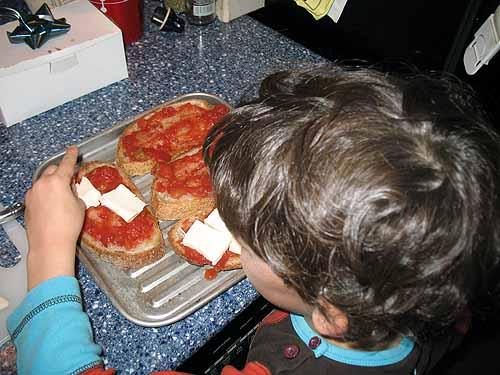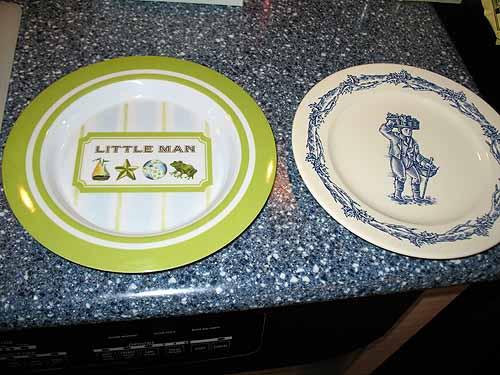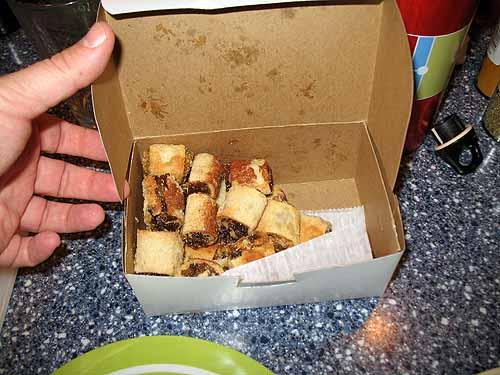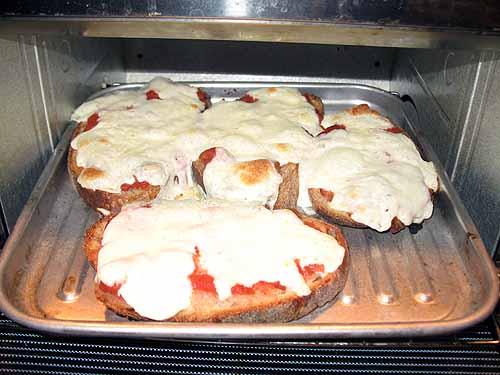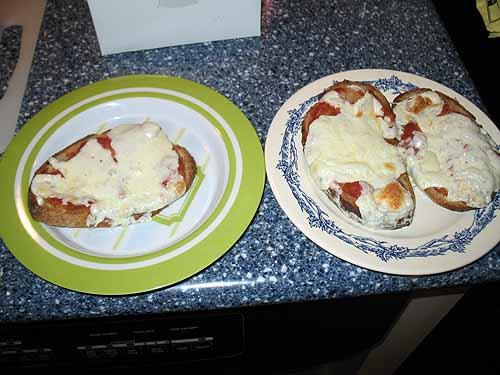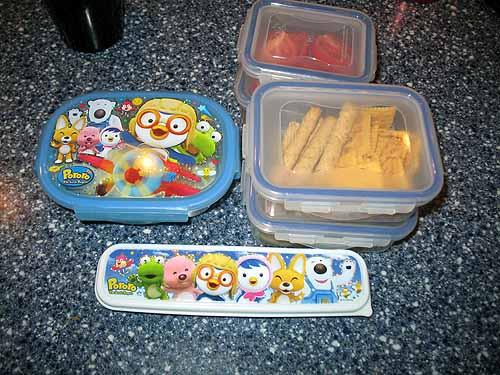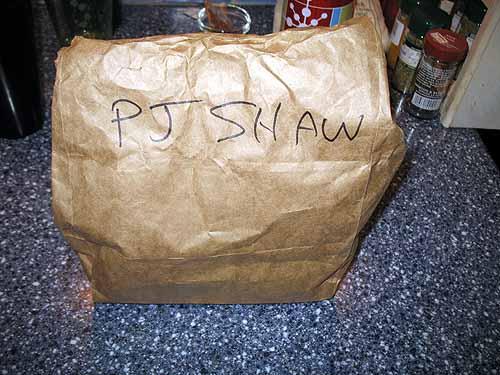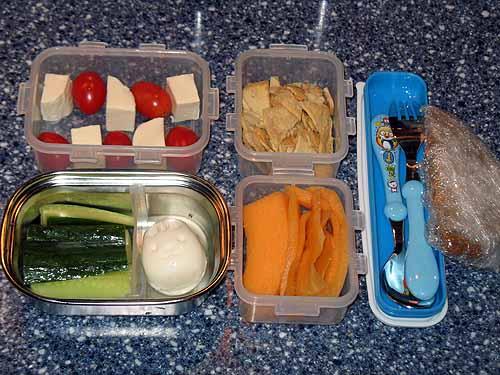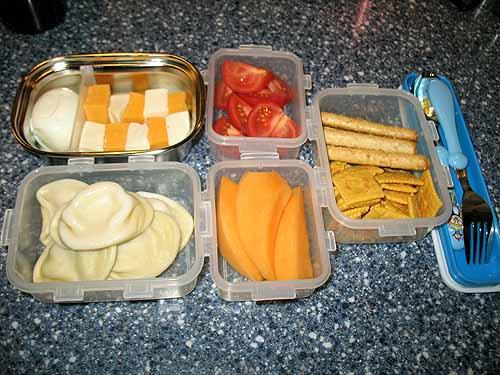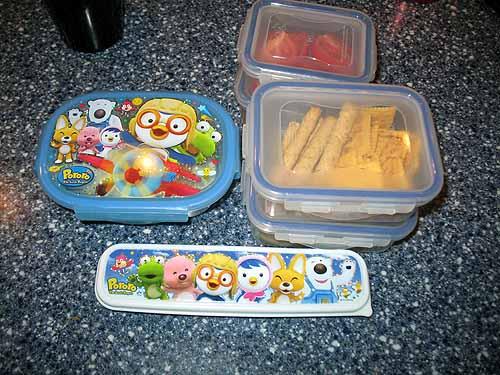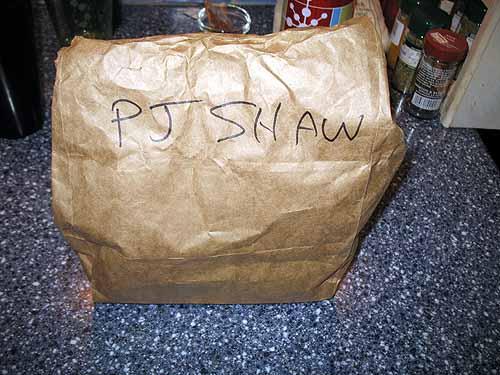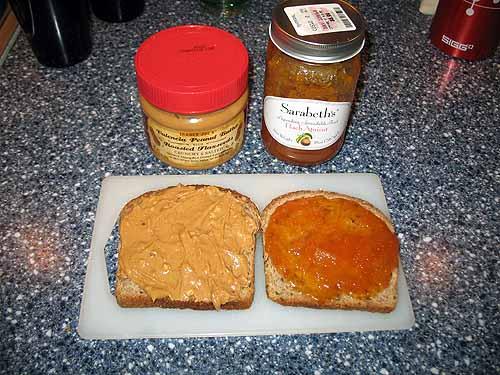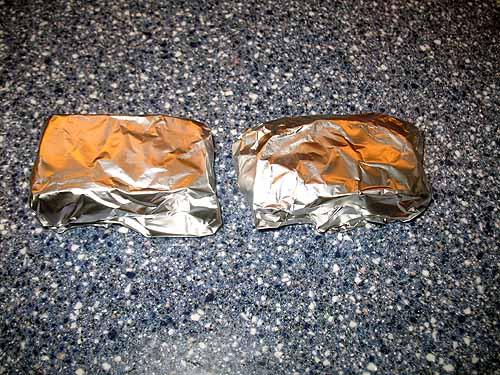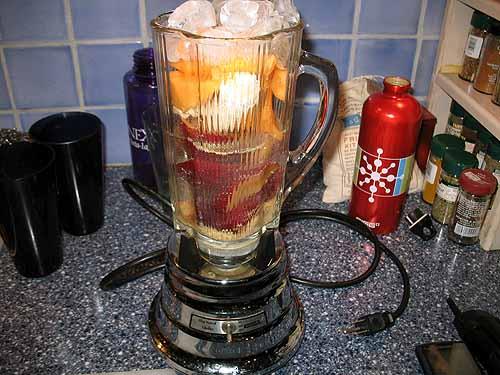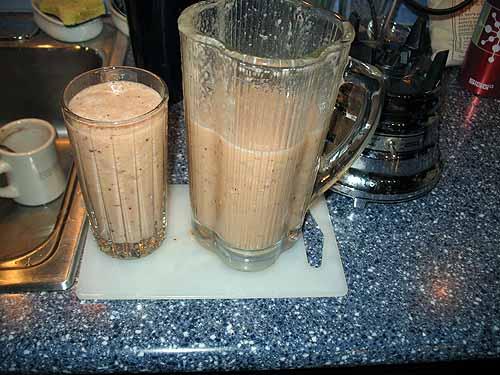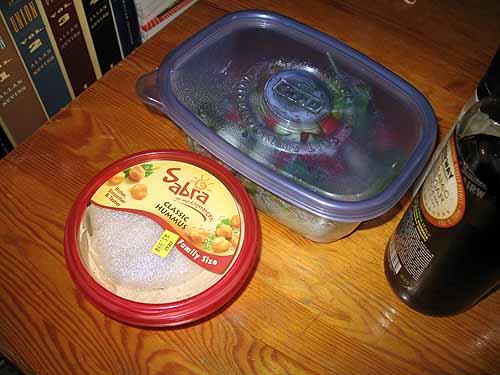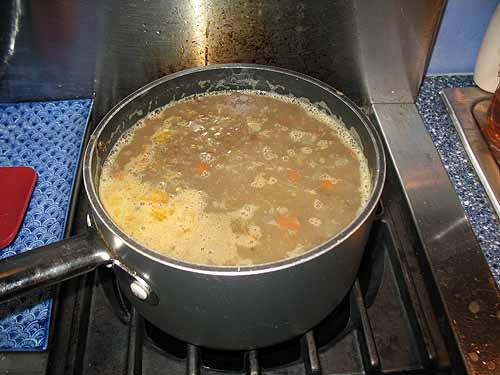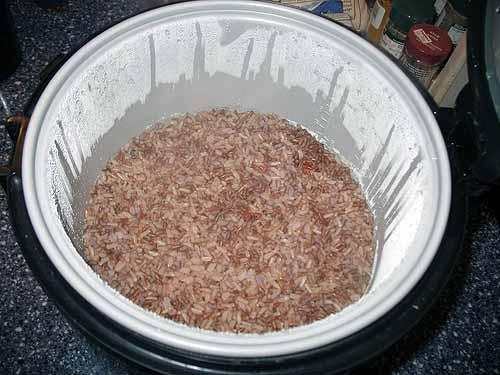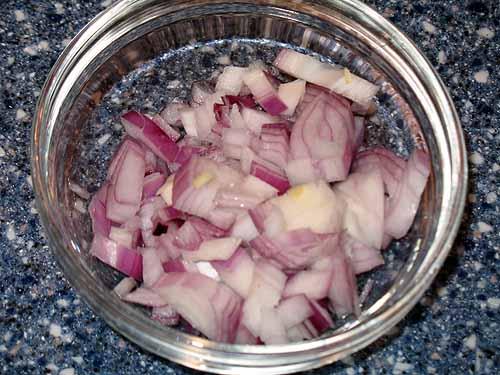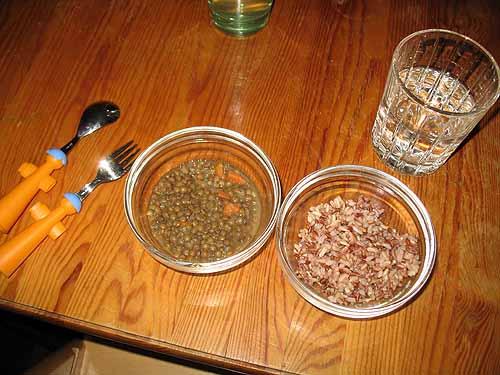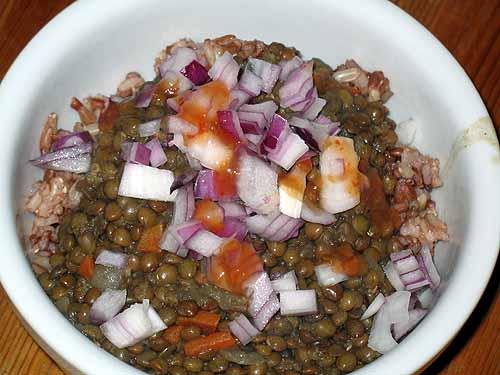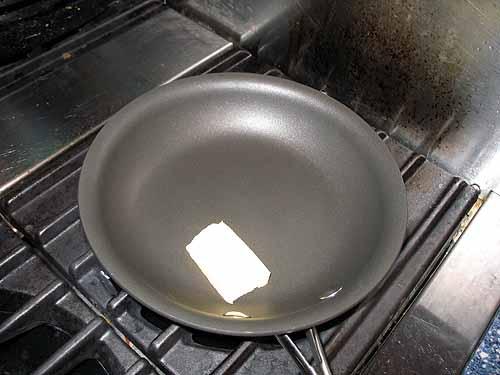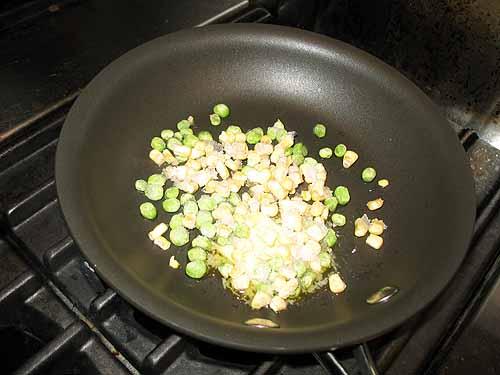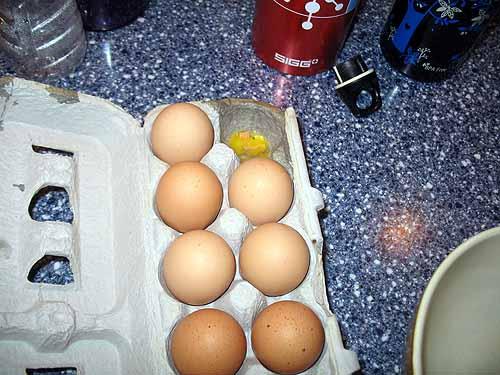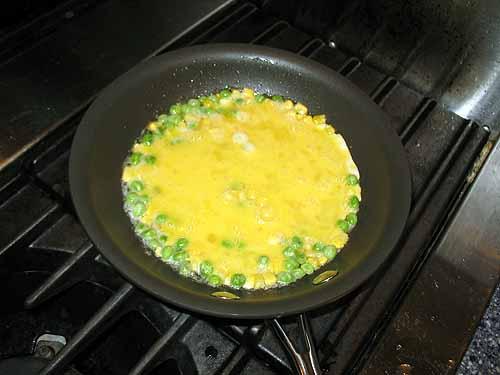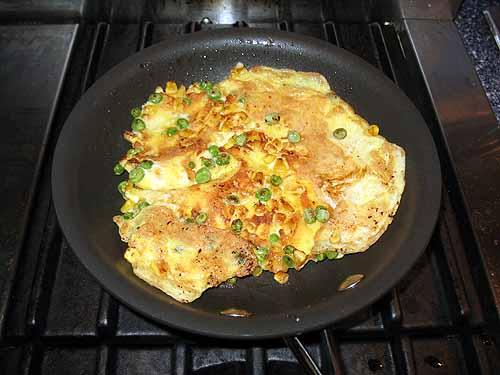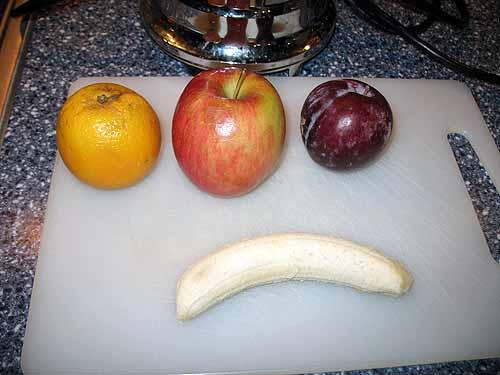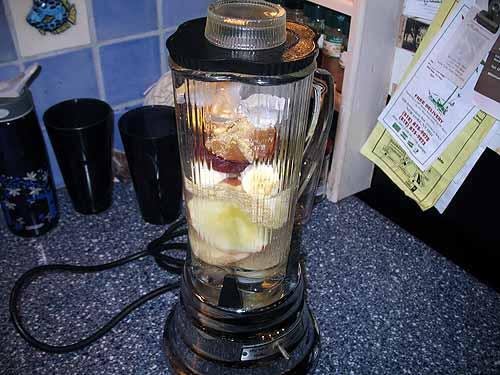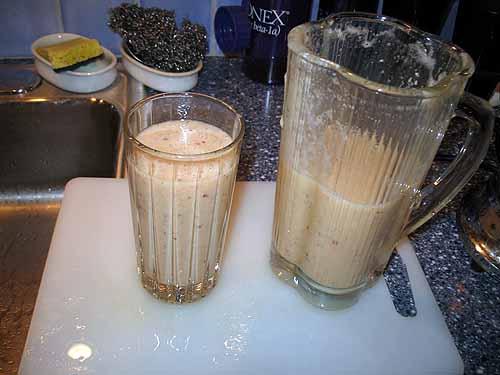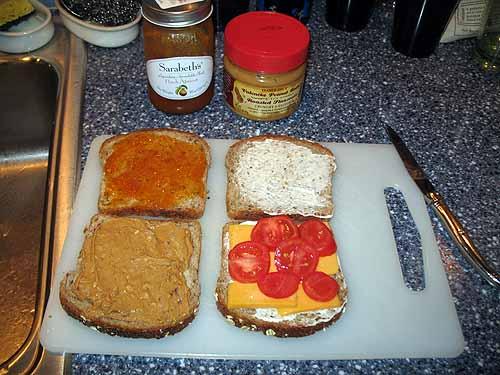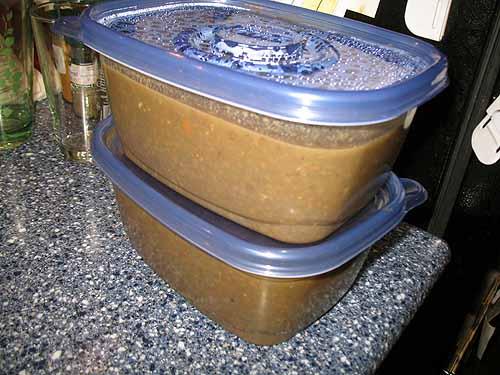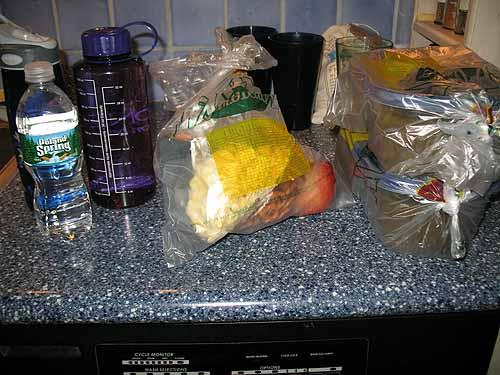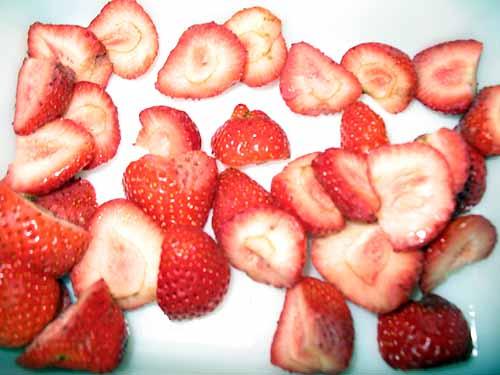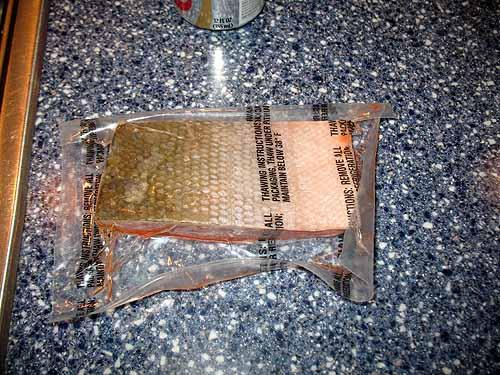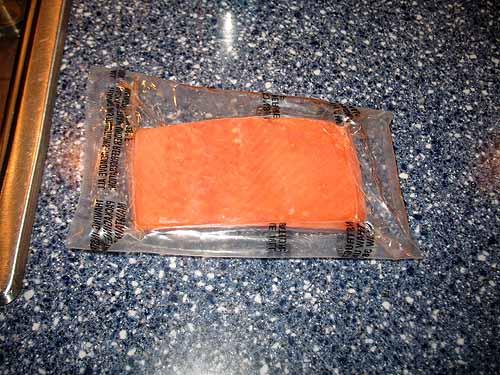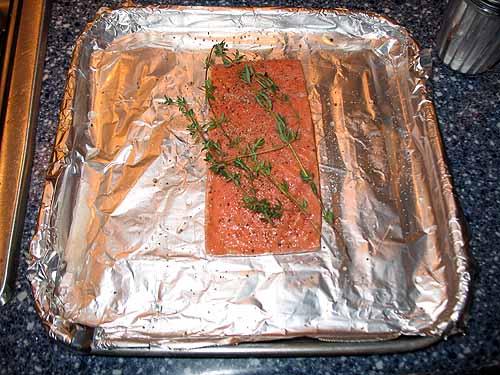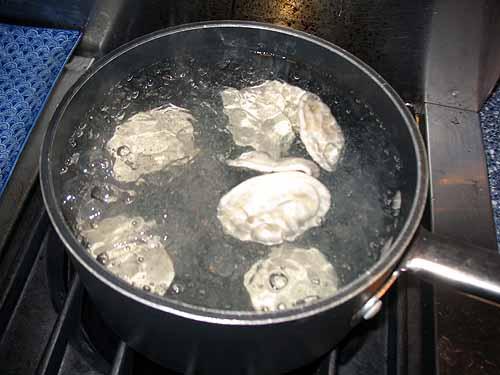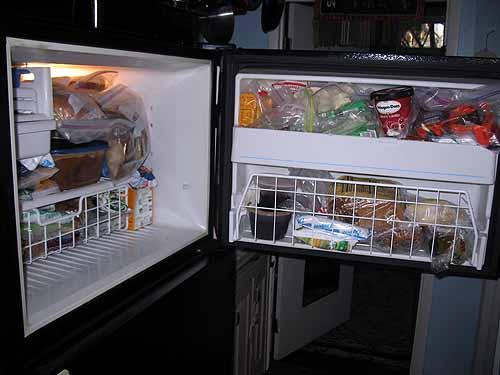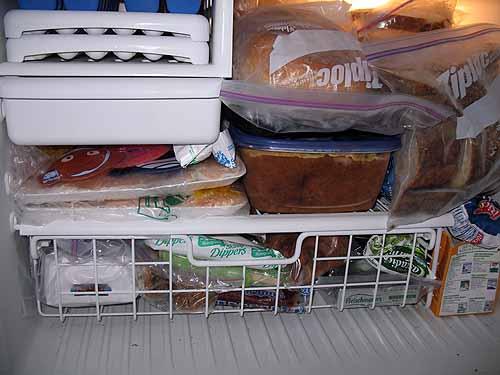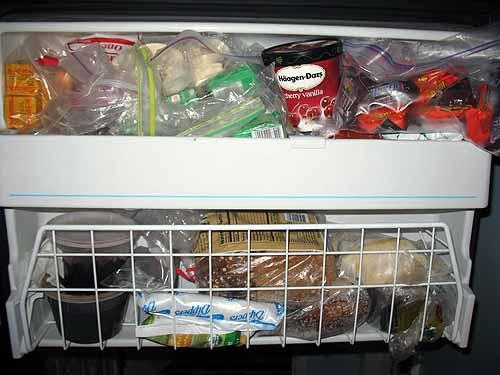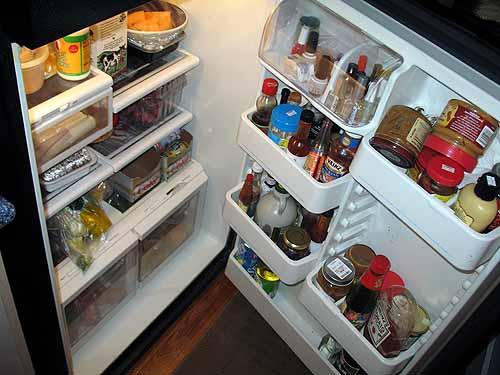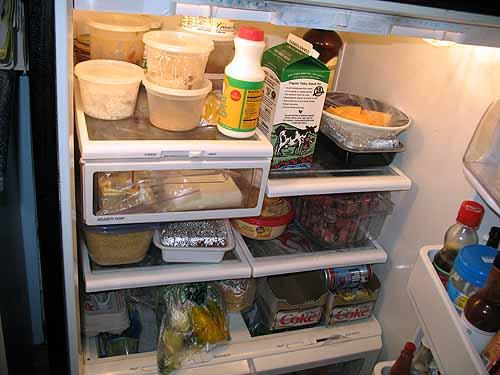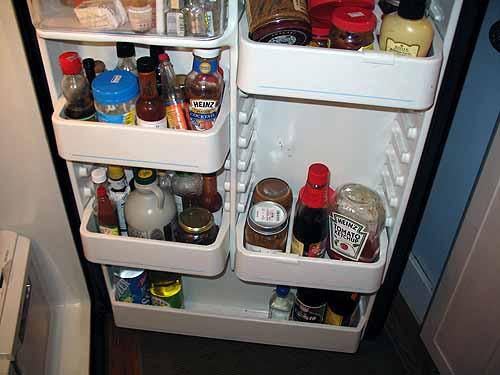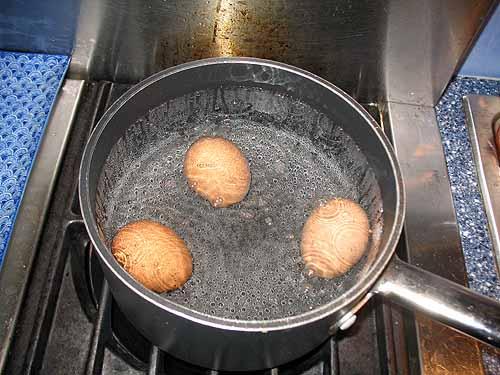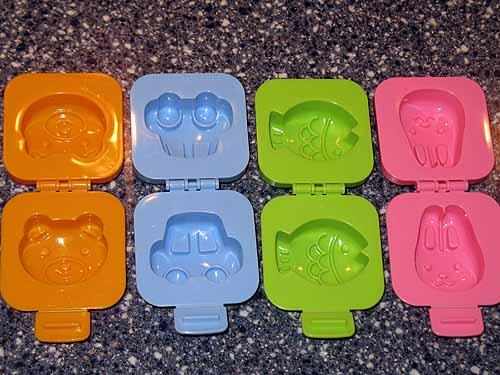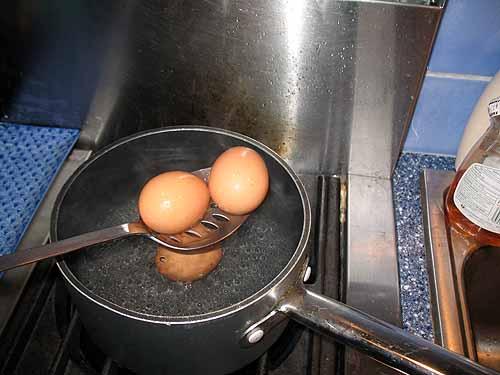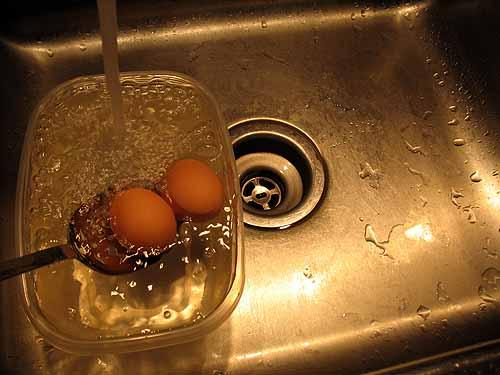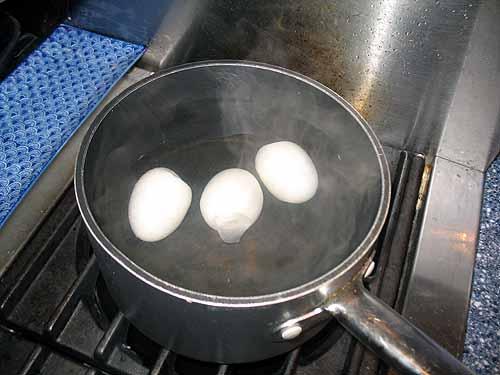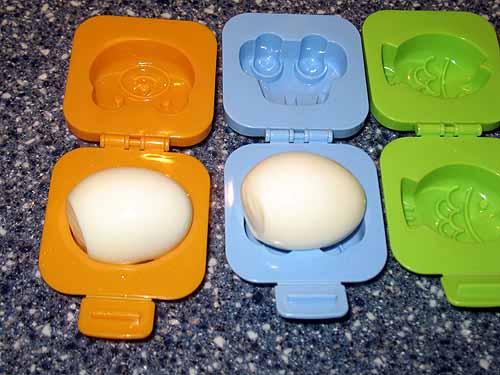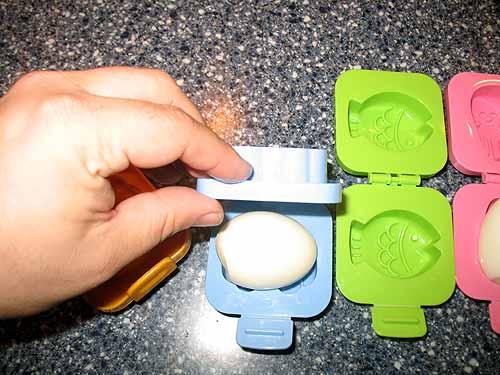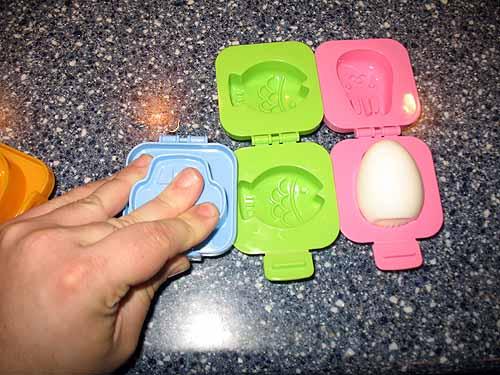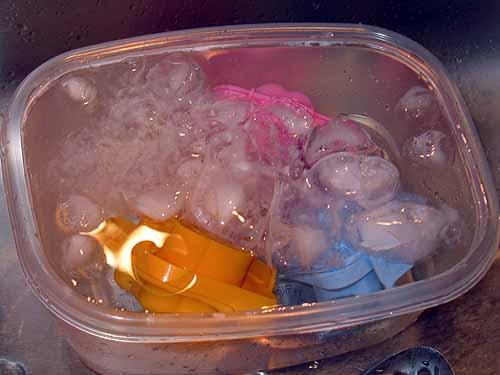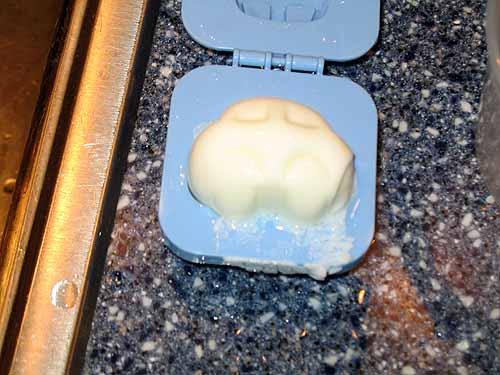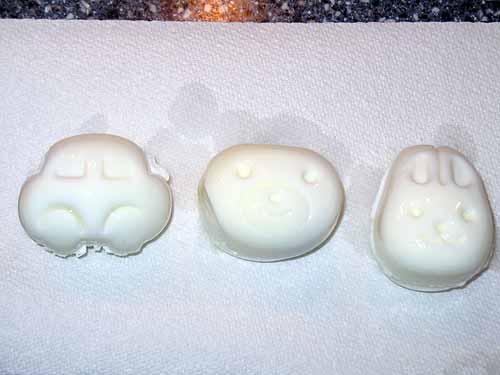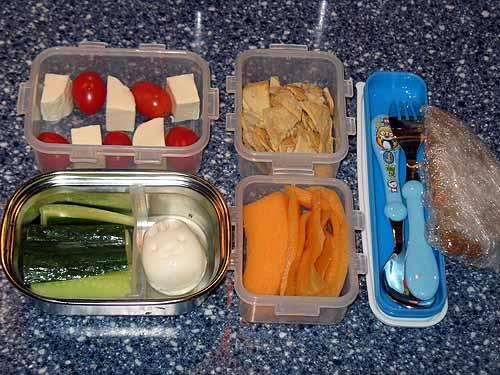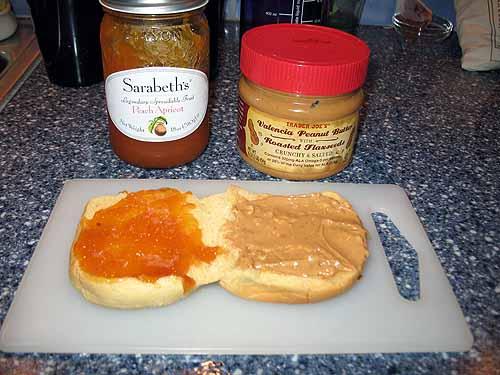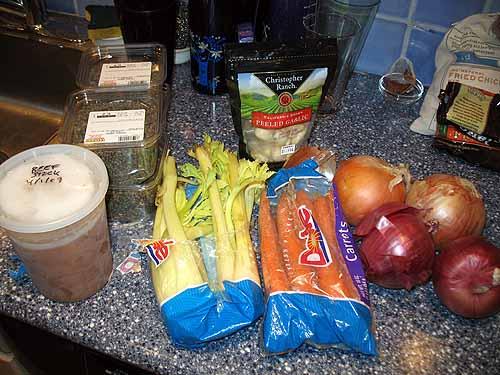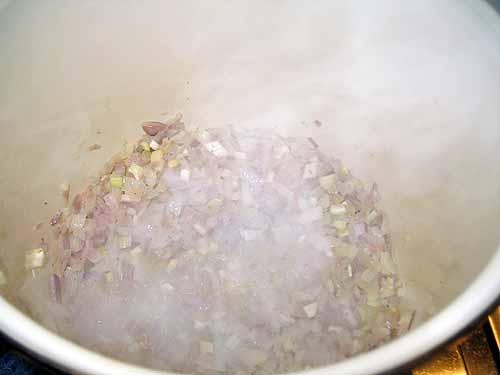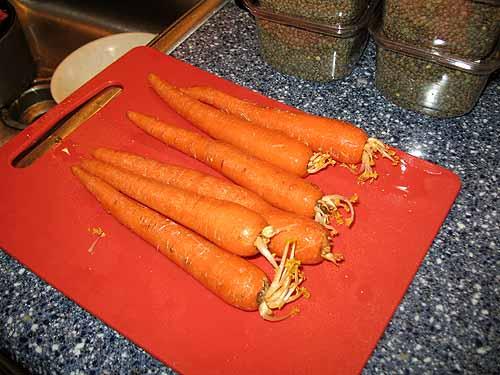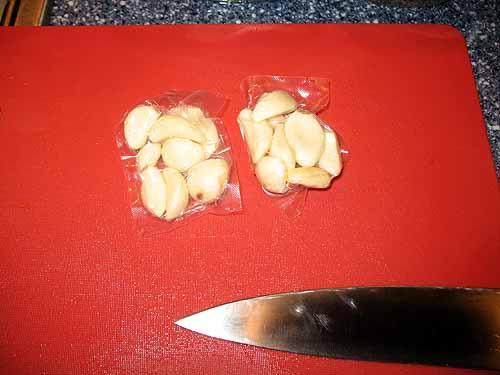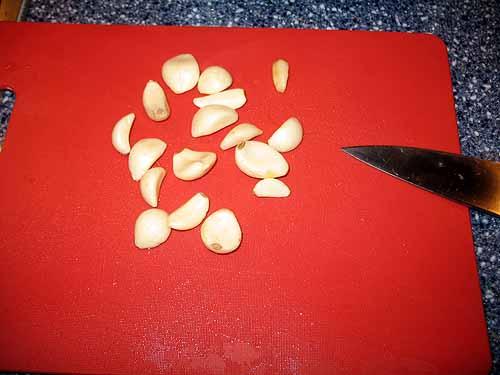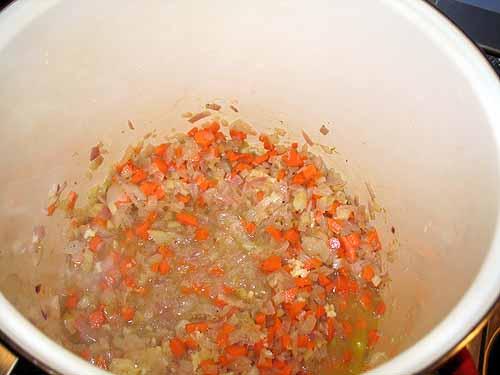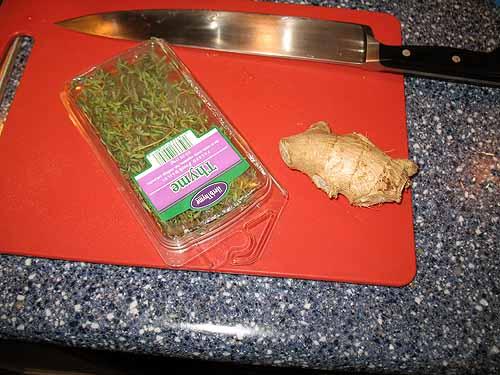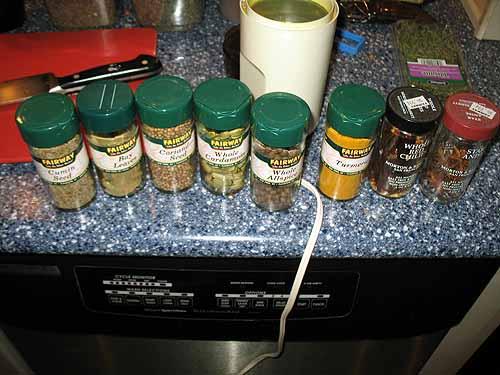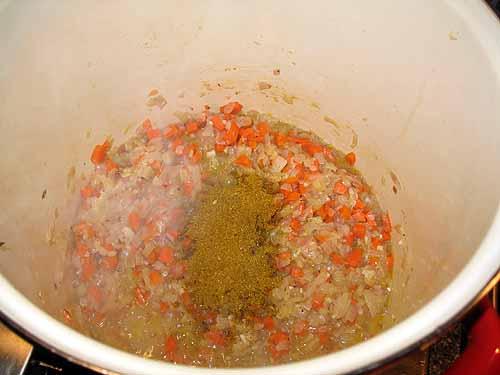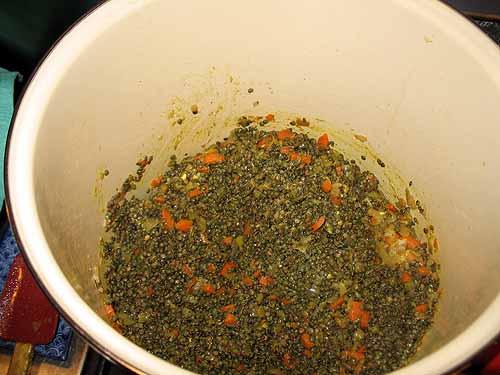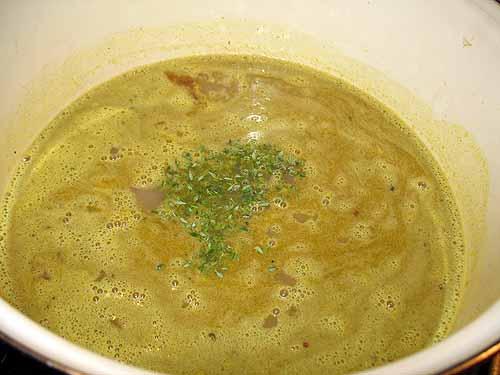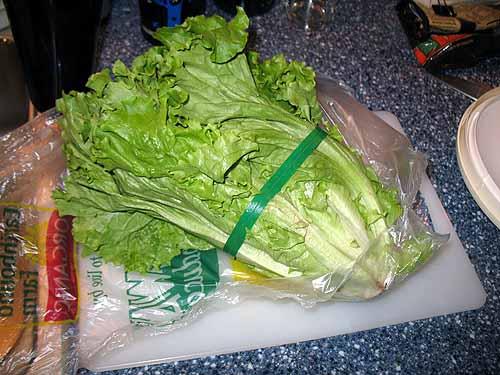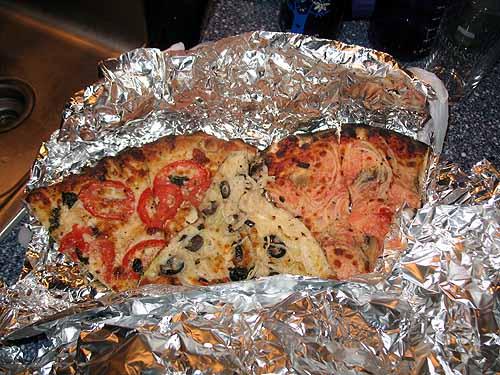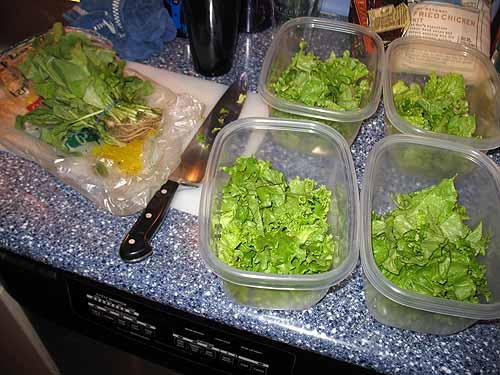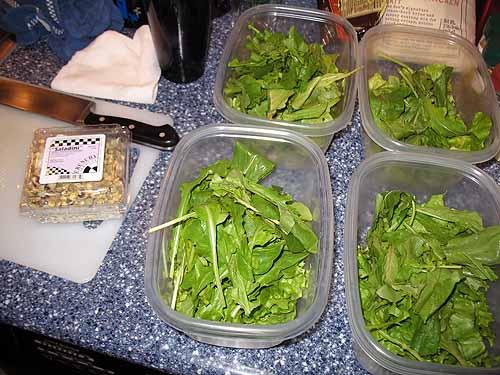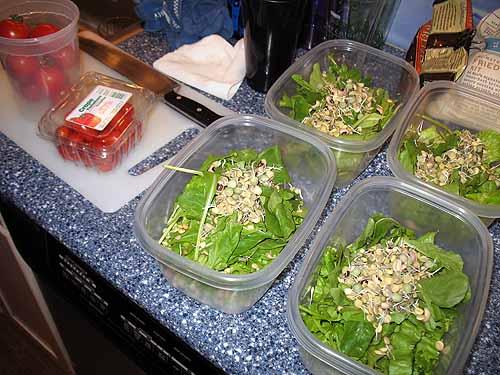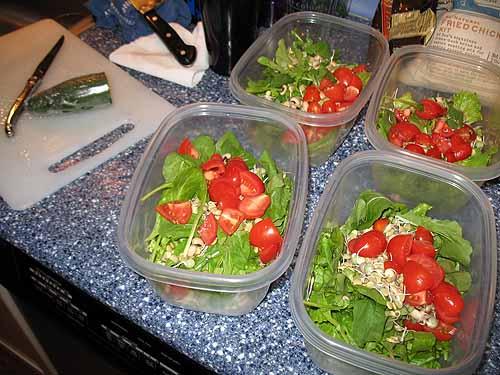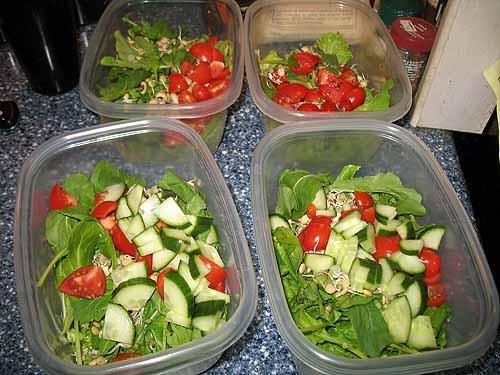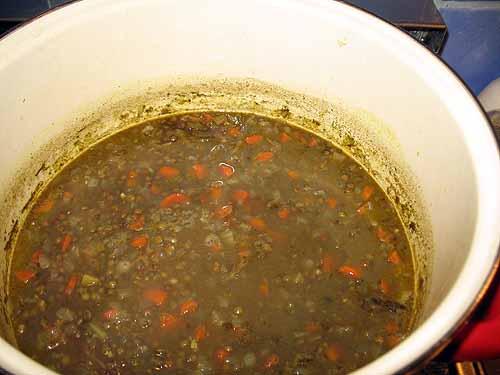-
Posts
28,458 -
Joined
-
Last visited
Content Type
Profiles
Forums
Store
Help Articles
Everything posted by Fat Guy
-
Does your SO like cold sesame/peanut-sauce noodles? A thick coating of that sauce really tends to mask whatever the underlying pasta is.
-
Photographic evidence will be scant until I can get my primary camera back. I was able to shoot PJ's lunch with Ellen's camera but there's a limit to how often I'm allowed to touch her professional equipment. I may do some cell-phone shots as light allows. But anyway, I was able to capture PJ's lunch today. We're really digging into the leftovers now: Pretzel rods (still have a ton of those left), a clementine peeled and sectioned (three remaining), some apple sauce (enough remaining to survive on for a month), cantaloupe (still a whole one left), cheddar cheese (that's the end of that), and crackers (still a few left -- getting down to the broken ones at the bottom of the box). For his breakfast: almond butter and jam on raisin challah -- a nice bread surprise I found in the freezer. That may make some nice French toast one day this week. I also got enough out of the refrigerator this past week that it was possible to remove one of the shelves for cleaning!
-
Yesterday we made the Thomas Keller fried chicken. I took lots of photographs and then left my camera behind in Connecticut. It may take a couple of days to sort that situation out. Once I have the unit back, I'll continue with the fried-chicken report. Now I guess I have to borrow my mother's camera today.
-
Breakfast this morning: pancakes, fried eggs and ham. Would have preferred bacon, but ham was what there was. Now off to sharpen some knives.
-
I did a quick Google search on it and found a number of explanations that demonstrate lack of basic scientific comprehension. But it does seem that every source agrees that a full freezer is more energy-efficient. Some manufacturers even recommend filling empty freezer space with milk cartons full of water to save energy. So I guess an unintended consequence of my lifestyle is an energy-efficient freezer. Go figure.
-
I don't know if this is true, but I've been told many times that a full freezer is more energy-efficient than a sparsely populated one. Is this for real, and if so is it true of refrigerators too?
-
I've been pondering a related question: does collaboration fit within the no-shopping framework? I think it probably does. Regardless, I've engaged in some. A few weeks ago Thomas Keller sent me a fried-chicken kit. Well, actually I'm not sure Thomas Keller would recognize me on the street. Rather, the publicity department at Workman/Artisan books sent me the new Ad Hoc At Home book along with a fried-chicken kit: If you've been looking at some of my earlier photos on this topic, you may have noticed that fried-chicken kit sitting on my counter. It has been taunting me ever since I received it. I really wanted to find a way to use it during the no-shopping period, but the only chicken I have in my freezer is two packages of boneless, skinless breasts. I just don't think those are worthy of a Thomas Keller fried-chicken kit. Enter my friend Sean in Danbury, CT, with whom we're visiting overnight tonight. Sean has an enviable inventory of chicken. So we're collaborating: my fried-chicken kit and his chicken. Likewise, for dinner tonight we managed a collaboration of my ravioli and salume, and a bunch of his stuff. It seems to be working well. No major disputes requiring mediation or anything like that. After making omelets for breakfast at home (the eggs are in a bowl on account of the other day's egg-carton disaster), I pulled together my gear for the Connecticut trip: the fried-chicken kit, some knives to sharpen with Sean's sharpening system, a couple of sheet pans, about 100 pieces of ravioli (the last time I was on Arthur Avenue I bought 200 mini cheese ravioli -- even after bringing 100 to Connecticut I have another 100 left in my freezer), and a couple of salume items (also from my last Arthur Avenue trip). For dinner we pulled together an antipasto selection from the Arthur Avenue salume and some olives and such that Sean had. We made a marinara sauce from onions, garlic, canned whole tomatoes and basil. There was a head of Romaine available so we made a salad and, apropos of the condiments discussion, pulled out many bottled dressings from Sean's fridge. After dinner we started on the fried-chicken project. Thomas Keller's fried-chicken recipe is a two-day process (no surprise there) and it starts with brining. The kit actually comes with enough to do two batches, but we're only doing one. We boiled water and added the brine mix, then cooled it on the back porch, butchered a whole small chicken and a whole large bone-in chicken breast, and put the chicken in the brine in the refrigerator to soak overnight. Tomorrow there's a soaking-in-buttermilk process, battering and frying. We'll probably do it as a mid-afternoon meal before we head back to NYC.
-
Depending on the definition of condiments, I do have some plans. It seems to me the only way to put a serious dent in condiments is to hark back to the recipes of the '70s that had ingredients like "1 jar of mustard" and "1 jar of currant jelly." I'll be doing something with frankfurters next week that should fit the bill. Unfortunately, I'd have to make the recipe about ten times to burn through all our inventory of condiments, and there's no way I have enough frankfurters in the freezer to support that.
-
I thought yesterday's food-preparation activities had concluded, but Ellen arrived home from her talk (she was speaking to a group of prospective nursery-school parents) and asked to be fed. Nobody was sure of the age of the leftover container of Chinese-takeout hot-and-sour soup, but it didn't smell bad or anything, so we figured why not? Today was a short day at school for PJ -- he gets out at noon on Fridays, so there's no school lunch. The plan for after school was to go to the holiday train show at the New York Botanical Garden in the Bronx. So it was another day of packing sandwiches and snacks. I'm finally making some progress on the bread. Unless I find more of it in the back of the freezer, I've finally used the last four slices of multigrain for peanut-butter-and-jelly sandwiches. One sandwich was PJ's breakfast for the walk to school, the other was part of the lunch inventory. I also made a couple of other sandwiches on FCI sourdough bread -- I now only have about half a dozen slices of that left. So, progress. For one sandwich I did hummus and mozzarella (trying to use up the mozzarella before it goes bad), and for the other I did cheddar, tomato and mayo. I assembled two types of pretzels, pita chips, rice cakes, rugelach, water bottles and the last of the bananas (which were almost past the point of usability) and we were off and running with our lunch feast. The camera batteries ran out at the Botanical Garden and are in the charger now, so no dinner photos. But it was just the lentils and rice you've seen before, supplemented with bits of this and that from the fridge. Tomorrow we're going to visit some friends in Connecticut so I'm not sure I'll be 100% on plan, but I'm bringing a bunch of stuff up there to cook with: two amazing salume things from Arthur Avenue that I've been holding on to, some cheese ravioli -- I don't know, it may be possible to do a leftovers dinner. We'll see. If not, I'll be back on program Sunday night.
-
I have two pot racks suspended from the ceiling, one directly above the refrigerator and one next to it. The two racks are the same make and model, but different colors -- the choice had to do with a clearance sale that made it cheap to do it that way. The proximity of one rack to the fridge limits the size of pots that can go on that one, and where. I also hang a lot of non-pot utensils (strainers, colander, ladles, etc.) off the racks. It's all pretty tight. But incredibly efficient. I can't even imagine how much cabinetry would be needed to hold all that stuff. I keep the pot lids on the grids above the racks.
-
The answer is yes. He ate four out of five of the cold leftover cheese ravioli. Another fringe benefit of the no-shopping challenge: by attempting something I wouldn't normally have attempted, I discovered that cold cheese ravioli are a potential inclusion in PJ's lunches. For those of you who make school lunches for kids, you know what a score it is to find a brand-new item that meets all the criteria of packability, convenience, etc... and that your kid will happily eat. It was just me and PJ for dinner. Ellen has a speaking engagement and will probably have some soup later or something, so for the father-son dinner I decided to make a pizza-like toasted cheese item: slices of FCI sourdough topped with Pomi crushed tomatoes and melted mozzarella cheese. PJ helped prepare the toasts, we cooked them in the toaster oven, and we served his on his "Little Man" plate. For dessert, some rugelach that Cousin Jane gave us a while back. These are going to come in handy for school lunches next week, if they hold. I also wanted to take this opportunity to give a tour of our "pantry," just so we see what we're up against. This is the primary pantry cabinet in our kitchen: We have another cabinet where a couple of shelves are devoted to things like flour: Elsewhere, the cabinet with all the oils, vinegars, salt, pepper and such: On top of the refrigerator, three plastic bins holding onions, potatoes, cans and boxes of tomato products, various crisps and such: Also part of a base cabinet is devoted to snack foods: No idea how we're going to tackle some of this.
-
I'm going to add this quote to the list of quotes I've been keeping since February. It's amazing to see the light bulb go on in so many people's minds. Everybody has a different experience, but almost nobody is left unchanged by attempting the challenge. Here are a few things your fellow members said last time around: “If you had asked me three weeks ago if I had any lasting thoughts about going a week without shopping, I don't think other than reminiscing about vague family memories, I would have come away with many more thoughts about my week of cooking without shopping. But in the three weeks since, I've found, somewhat surprisingly, that the thoughts that were provoked during my week now carry with me every day. Every day I think about not wasting food, not wasting time or money, and making do with what I have. I think about the rough times others are going through, and I'm thankful I have a freezer, refrigerator and cupboards full of food. I think about how wasteful I was in the past, and I challenge myself to remember that. I think today should be the start of another week of going without shopping, and it will be.” “I have learned, been inspired, and have been motivated.” “I feel less weighted down by stuff, both in the kitchen and out.” “I've realized that I can maintain my standard of quality of cooking while using only what's on hand…. This has been loads of fun.” “There is more space in our refrigerator, pantry, and freezer. I am now able to see most of what is in each - and plan the next meal accordingly.” “My fridge looks better than it has in ages…” “I have enjoyed the challenge of creating something exceptional with what is on hand.” “Planning makes it so much easier to have the right things prepared when I come home starving and with no patience.”
-
Lunch today sort of did not happen. It has been a writing day and I've been noshing on whatever is around: a plum, some pretzels, some chocolate, etc. Maybe dinner will be a real meal worth reporting on.
-
From 1987 through 1991 I attended the University of Vermont, in Burlington. It's where I met my wife, Ellen, on the first day of school. And we still have friends who live and work there. For example, Ellen's best friend from college (and maid of honor at our wedding) is now director of admissions at the university. Her husband, also a schoolmate of ours, practices law in Montpelier. They have two kids close in age to our son, and a big house in Williston, which is basically a suburb of Burlington (to the extent Burlington is enough of an urb to have suburbs). In the past almost 20 years, the cuisine scene in Burlington has improved dramatically. The impact of the New England Culinary Institute (NECI) has been felt in restaurant kitchens all over the area, locavorism and food coops are now well established, and there are all sorts of artisanal ingredients and ambitious culinary projects underway that didn't exist in the late '80s. Last weekend, however, the new wave of Burlington food opportunities was not my mission priority. I wanted to visit my three favorite old college haunts: Al's, Nectar's and Bove's. Al's French Frys [sic.] is a Burlington institution dating back to the 1940s. It's reminiscent of a Southern California car-culture burger stand. In good weather, guys with cars with big engines stand around the parking lot comparing carburetors and eating burgers, fries and soft-serve ice cream. The place is always busy. The fries -- the signature item -- are fried twice in two temperatures of oil, and there's a rumor that one of the frying stages involves a percentage of beef tallow. Whether or not that's true, the fries are excellent. Other items, like burgers and frankfurters, are standard-issue: better than McDonald's and not as good as a real restaurant. Surprisingly, Al's is still a single-establishment operation (though they do have a mobile rig that sometimes shows up at fairgrounds and such). It seems eminently franchisable. Nectar's is another cornerstone of Burlington, for music as well as food -- it's basically the local equivalent of CBGB, except it's still open. When I was in college, Phish played regularly at Nectar's, and there has been a long history of good live music there. I believe Nectar's became Nectar's (it was a bank previously) in 1975 when a gentleman named Nectar Rorris -- I think he came to Burlington from Hawaii -- renovated the two-level space into a downstairs bar/lounge/music place and an upstairs dance club. I'm pretty sure Nectar sold the place to new owners a little while back. Thankfully, he left behind his recipes. My memories of Nectar's involve taking a tray through a cafeteria line, where Nectar himself would carve either turkey or roast beef for you, making an open-face sandwich. Then he'd scoop an alarmingly large portion of fries on the plate and cover everything with his family-recipe gravy. The cafeteria line is now gone and the space has been spiffed up a bit. You order from a waitress and the food comes out of the kitchen in the back. Thankfully, the hot open-face turkey sandwich with fries and gravy tastes the same now as before, at least to me. Finally, Bove's. We ate a lot of meals at Bove's in college. The basic procedure at Bove's, which is an Italian restaurant in an Art Deco cafe/diner building dating to 1941, is you order pasta with a choice of sauces. The choices are spaghetti, ziti and ravioli. The sauces are garlic, tomato, vodka, mushroom, basil and red pepper. There are some other things on the menu too, like an antipasto assortment. The meal starts with soft white bread of astoundingly poor quality that is nonetheless impossible to stop eating. The pasta is not overcooked. The sauces are quite good. Bove's has, in fact, been selling its sauces commercially for the past few years and I've even seen them around New York City. To me, by far the best Bove's sauce is the roasted-garlic sauce, available in either a red or white permutation. The white is my preference. It tastes like the sauce from linguine with clam sauce, except there are no clams and there's 20 times as much garlic. It's a garlic lover's dream. You sweat garlic the next day. Al's and Bove's are totally kid-appropriate. Nectar's kind of isn't.
-
Only two lunches this week. School was closed Tuesday and Wednesday for parent-teacher conferences. And no lunch on Fridays on account of the noon dismissal. So, for Monday: And for today (Thursday) I've been chronicling the process in more detail on the Don't Shop Now topic, where several of us are cooking for a week without grocery shopping.
-
Is anybody going to be brave enough to step up and do a Thanksgiving dinner without shopping? Me, I'm going to be a guest at someone else's house for Thanksgiving. Three houses, actually, on both Thursday and Friday. But I'm sorely tempted to create a Thanksgiving meal without shopping. Turkey wouldn't be part of it because I don't have a turkey in the freezer. But I could put together a nice meal I bet.
-
Okay, now it's time to address some concerns I've been hearing. Last time we did this, and this time, I can't tell you how many emails and other comments I received saying "This is a cool idea but I can't possibly do it..." I've made a compilation of some of the most common issues here. Why You Can and Should Take the Don't-Shop-Now Challenge Until you take the challenge and emerge victorious, you’ll have lingering doubts. I know. I've now seen scores of people work through the challenge, and there's no substitute for actually doing it. Once you get through the week -- or in many cases once you get through just the first couple of days -- your perspective will start to change. I'm not asking you for seven years in Tibet, let alone 100 years of solitude. I'm just asking that you not buy groceries for a week. Yes, you’re hesitant. At the beginning, many people told me I was crazy for undertaking this challenge. Society members, several of my closest friends and even my wife had long lists of objections, excuses and rationalizations. All of those will be refuted as we progress through this week and beyond, but a few common doubts and fears can be addressed here: "We have no protein other than what we buy fresh for immediate use. If we take this challenge we won’t get enough protein." This is what one friend argued when I proposed the challenge. So I went over to his house. When I looked around his kitchen I found: about ten cans of tuna, almost two dozen eggs, several pounds of beans, a little cheese, a pack of bacon and some frozen pigs in blankets (miniature frankfurters wrapped in puff pastry) – surely enough protein for a couple with two children to survive for a week without suffering a deficiency. Digging deeper would have yielded more discoveries, but once I started holding up products and shouting, “Aha!” my friend shooed me out of the kitchen. A lot of people, especially in the West, make large hunks of beef, chicken and pork the centerpieces of their meals. We buy, eat and think about meat by the pound. But healthy, happy, totally un-deprived people in many other civilized countries eat just a couple of ounces of meat at a time -- as strips of meat in stir fry, as chopped meat mixed with beans, as meat in a pasta sauce, as bits of meat in fried rice -- or no meat at all. A mountain of scientific evidence demonstrates that this is simply a better way to eat if you want to live a long life. Not to mention, even though meat is relatively cheap, rice, beans and pasta are a lot cheaper. “What about fresh vegetables?” A couple of years ago in the New York Times, the great chef Michel Richard sent food snobs into a panic when he confessed that his renowned sautéed Brussels sprouts were made from frozen Brussels sprouts. His rationale: they’re better. Every supermarket in every town across America has fresh produce year-round, shipped in from the far corners of the planet. I don’t mean to take anything away from that accomplishment when I say: fresh vegetables are overrated. Those flawless-looking fruits and vegetables in the supermarket are often weeks old when purchased. Many are grown half-way around the world, from plant stock selected for attributes other than flavor and nutrition, then picked young and ripened artificially -- sprayed with noxious chemicals in the holds of enormous cargo ships. Meanwhile, many frozen vegetables (and fruits such as strawberries) are picked in season at the height of ripeness and frozen quickly in nearby facilities, locking in their nutritional value. Several recent studies have shown that, on average, frozen vegetables and fruits are more nutritious than out-of-season, shipped-in produce. Personally, I’m a big fan of frozen peas (and so is Mario Batali). The frozen peas I buy are better than the fresh peas I can get any time of year, except maybe a few fleeting weeks in season. Ditto for the frozen berries. I mostly use frozen spinach in any dish that requires cooked spinach. Frozen broccoli and corn, too. It’s also possible to freeze a lot of items yourself. Early in my challenge back in February, I had a box of mushrooms in the fridge that looked like it wasn’t going to last much longer. So I sliced them up, sautéed them, put them in a pint deli container and froze them. Later, I added them to tomato sauce. They were great. I also added frozen basil to the sauce -- basil I’d washed and frozen when I had a huge bunch that I couldn’t use all at once. When I added it to my tomato-mushroom sauce, my home smelled like an Italian restaurant within moments. Speaking of tomato sauce, freezing is not the only way to preserve fresh produce. Most professional chefs will tell you that canned tomatoes are better than fresh most of the year, and to me, the new tomatoes in foil-lined aseptic paper boxes are even better. Not that all fresh produce needs special preservation. Fresh produce is a lot more durable than most people think. Potatoes, onions, garlic and shallots can last for months in a cool dark place. Apples can last for weeks or months in the refrigerator. Oranges and grapefruits do fine just sitting on the counter for a couple of weeks. At the beginning of my February challenge, I had a small head of radicchio in the refrigerator, already a couple of weeks old. It survived the entire month; every time I took it out to make a salad I marveled at the stamina of this little vegetable. "We live in the Bay Area and have great access to the farmer's markets, so we just don't keep much around in our kitchen. No canned food, no frozen food, no packaged food other than pasta." Some friends in California made this claim, so I asked them to photograph their freezer, refrigerator and cabinets and email me the photos. Their claims were false. The produce in the refrigerator, if rationed, would easily yield small but sufficient portions of fresh produce for two people every day for a week. They had a walk-in pantry full of comestibles, including many products in jars (how is that not "canned food"?). And, get this, there were steaks in the freezer! Grass-fed, no doubt. “Our milk/eggs/juice/butter are going to expire.” No they aren’t. This is a common misconception people have about the dates on food packages. Take a look at what it actually says: in most places it’s called a “sell by” date or equivalent. That just means a store isn’t allowed to sell the product after that date. Very often, the local laws require that food be safe to eat for at least a week after the sell-by date. Even so, food doesn't rot on a precise schedule. While milk is usually safe to drink for a week after the sell-by date; it's more important to make sure it hasn’t started to smell bad (which I've also seen happen before the sell-by date, in cases of improper handling/shipping). Eggs are often reliable for many weeks after their sell-by dates, so long as they don’t appear spoiled. And many foods, when they’re approaching their sell-by dates, can be frozen in order to extend their lives. Milk freezes almost flawlessly. So does juice. We always keep our extra butter in the freezer. “But my baby needs formula!” We're not trying to harm anybody here. If your baby needs formula, or you're caring for an immune-compromised person who really needs a specific food item every day, then of course you should make an exception and buy it. But before you define everything you buy as an absolute necessity, give it some thought. For example, just because you're the kind of person who eats the same thing for breakfast every day doesn't mean you'll be harmed by eating something else for a few days. "My kids are picky eaters." So are everybody's kids. Many, many people who have taken the no-shopping challenge, myself included, have young children. Try to involve them in the adventure of the no-shopping challenge, if they even notice that it's going on. If that doesn't work, and if they're really going to go hungry without some supplemental purchases from the grocery store, then make those exceptions for them -- but not for yourself. "We have company coming." Great. This is when you'll really learn what's possible during your no-shopping week. Pull out all the stops. Prepare a feast. Your guests will never notice the missing ingredients; they'll only notice it's the best meal you've ever served them. It's just not necessary to spend a lot of money entertaining guests. In the poorest countries in the world, people extend hospitality whenever visitors come. In the richest countries in the world, where most of our members live, we should be able to do it without an expensive trip to the grocery store. +++ I'm not saying 100% of our members can take this challenge. If you live in a tiny apartment or dorm room, you may really have no inventory. And many people, even in a time of plenty, struggle to earn enough to feed their families. But if you're not living in poverty (or college), before just giving up, take a good look around. Do you have a pantry? A cabinet that's like a pantry? Even one overhead cabinet full of food (as I do)? Do you have a garden out back? What about the refrigerator? Think about everything that's in there. A basket of root vegetables? A braid of garlic? A bowl of fruit? Do you really know what’s in your freezer? Do you have a second freezer? I live in a New York City apartment that is tiny by the standards of American homes. A suburbanite would consider my Maytag refrigerator-freezer puny. My root cellar is a plastic bin on top of said refrigerator. One two-door overhead cabinet is my so-called pantry; two other cabinets hold things like olive oil, condiments, pretzels and crackers. No walk-in pantry. No second freezer. Nothing like that. My family is in a fairly low percentile of per-person square footage for the U.S., and we had no problem going without shopping for a whole month. The only challenge was to see just how well we could eat.
-
One of the lunch-making strategies revealed over on the bentos topic is to utilize small bits of leftovers for a child's lunch. Portions too small to make a meal can be a component of a lunch. The other day, I made ravioli and five of them went uneaten. Will PJ eat leftover cold ravioli as part of his lunch? We'll find out today. It doesn't really matter, as he's in no danger of starving given all the other stuff in his lunch: a hard-boiled egg molded to look like a bear, two types of cheese (cheddar and mozzarella), tomatoes, cantaloupe, crackers and pretzel rods. For his breakfast, a peanut-butter-and-jelly sandwich packed in two separate halves, to be eaten on the walk to school. PJ sometimes sits and eats his breakfast at home, and sometimes likes to eat it while scooting/strolling through Central Park. Today he wanted a portable breakfast. In thinking about peanut butter and jelly, I think we have enough of it to eat for about a month. I'm not a major consumer of Trader Joe's products -- most things they have there, I feel like I can get better elsewhere -- but I do think they have the best peanut butter available in any mainstream store: Valencia peanut butter with roasted flax seed. The stuff is amazing. Because I go to TJ's so rarely, I buy four or five containers of it. In addition to the one I've been using this week, there are two more in the cabinet. That Sarabeth's jam is also something we have a surplus of. My mother-in-law found it on clearance at TJ Maxx and stocked up. Then there's the matter of bread. One of the great perks of teaching at the French Culinary Institute/International Culinary Center is access to the bread from the baking program there. The students take such care with the bread, and the instructors are so good, that the FCI bread kitchen is one of the best bakeries in New York. You can't buy bread there, but if you're in the building around 3:30pm you can get bread for free. I often come home with a loaf or two -- or six. My freezer is absolutely jam packed with sourdough, multigrain, raisin bread, baguettes and brioche from FCI, in addition to various bagels, rolls and breads of unknown origin. I don't know how it all fits. Of course I'm also capable of baking bread. I doubt we would run out of bread even over the course of a couple of months. And that's not counting things like crackers and crisps, which our cabinets are full of. For the adult breakfast I made a fruit smoothie. I'm trying to prioritize the fruit in order of perishability, so I haven't yet dipped into the frozen-berry supply in the freezer. That will be for next week. Right now I have a lot of plums, bananas and cantaloupe that are on their last legs, so those are the fruits I used today. Plus a couple of tablespoons of flax meal. I noticed, when packing PJ's lunch, that the mozzarella is approaching its sell-by date. I'm thinking maybe that means I should do pizza or something related this evening. I'm bummed I didn't think of it last night when I could have started a preferment for dough. But I'll consider pizza or a pizza-like project this afternoon. Maybe instead of making dough I'll do something with the bread in the freezer. PJ loves French-bread pizza. That's one option. I'm thinking about it.
-
The plan was to make breakfast, pack lunch and spend the day at the New York City Transit Museum in Brooklyn. PJ requested, for breakfast, a vegetable omelet. There were bags of corn and peas in the freezer so I decided to do an omelet with corn and peas. Then all hell broke loose. First, it turned out that there was a broken egg in the carton of eggs I was using. When I pulled the carton out of the refrigerator, half the broken egg's insides wound up on the refrigerator shelf, dripping down onto the floor. So while the corn and peas were heating in the butter, I was addressing a confounding solid-waste disposal problem. Second, there was a surprise declaration that the departure schedule was being moved up. I was instructed to cook the omelet well-done and make it into a sandwich. I also had to pack fruit, pretzels, cheese, crackers, sandwiches and all sorts of other snacks and lunch items. Some time during this process, Ellen took the camera and threw it in the bag she would be carrying for the day. So nothing past the flipping of the omelet got documented photographically. For dinner we drew upon the lentil and salad reservoir. I also made rice, actually a mixture of brown and red rice as documented on the blending rice topic. We have a bunch of hummus to work through so we put that out for use as a salad topping, mixed with balsamic vinegar. I chopped up a quarter of a red onion (I'm down to 2 3/4 red onions now) and served rice topped with lentils, chopped raw onion and hot sauce. PJ prefers his rice and lentils segregated and without onions or hot sauce, so he got small, separate bowls of each. Now I have to think about what to pack for his lunch tomorrow.
-
That's great! To be clear, folks, you can start the challenge any time. We'll keep it running for a month or so, and you can start chronicling your week today, tomorrow or whenever. It's not too late to get in on it.
-
For a few days, undressed, in a sealed container under refrigeration, yes. I've never tested the limit, but I often produce four days worth of salads at once and have not had a problem with that time frame. I find that if I do a four-day salad production, I'll serve salad with dinner every day for four days, even if the dinner-prep schedule is rushed. Whereas, if I have to create salad day-by-day, washing all that lettuce and chopping the vegetables and such, I'll skip salad on the nights when time is limited.
-
I'm not sure how many days of fruit smoothies my inventory can support, but I suspect quite a few. Two recent weekends of apple picking have caused an apple glut, there are lots of bananas and oranges around, and then later we'll get into all the fruit in the freezer. So, this morning I went with apple, plum, orange and banana. Our plan for the day was to go to the New York Hall of Science in Queens, so I packed some sandwiches and snacks. I did cheese, tomato and mayo, as well as peanut butter and jelly for the sandwiches. Also pretzels, almonds and rice cakes. And I packed about a gallon of lentil soup to bring to that friend who recently had a baby. A little too late to add them to the smoothie, I found some languishing strawberries and we ate those as a post-breakfast/pre-departure treat. It was a gorgeous day, weather-wise, and we had our lunch feast at a table outside by the Hall of Science playground. Dinner was a little bit of a hodgepodge. I found a piece of salmon in the freezer. Costco sells very good wild salmon in individual vacuum bags. At some point a while back, we bought and ate a bunch of it, but somehow this one piece was left over. I defrosted it and cooked it in the toaster oven with salt, pepper, lemon and thyme. Also made some ravioli. And we had one of the salads. And some miscellaneous other snacks. I also wanted to give a shout out to our member Shalmanese, who has been working on a project that is spiritually kindred to the no-shopping challenge: preparing a dinner feast for $1 per person. Worth checking out if you find this topic interesting.
-
I'm talking about picking not in the gardening sense but in the sense of getting the little usable herb part of the thyme separated from the woody stalk part. This task takes me forever. Somebody must have come up with a trick to exfoliate the thyme with little effort. Tell.
-
The no-shopping challenge back in February had what felt like a big impact on my grocery-shopping habits. To wit, it has consistently knocked about 1/3 off the weekly grocery bill. In addition, I have probably skipped four or five weeks of shopping here and there during the past eight months. I now shop with current inventory in the front of my mind, and when given the choice I use what I have rather than buy new stuff. Yet, behold the monstrosity that is my freezer in November: And the refrigerator: That's not even getting into the cabinets and nooks and crannies where food is stored in our kitchen, which is a small kitchen by American standards. So, as before, it is unlikely that a family of three (me, my wife Ellen, and our four-year-old son PJ) can put much of a dent in the inventory in a week, or two, or three... But we'll try. There's also a new wrinkle this time around: we may be moving. I can't get into the details because there are all sorts of variables and legal considerations, but the current mission priority is to reduce inventory to as close to zero as possible over the next couple of months, so that in the event we move we don't have to move cartons and cartons of rice, pasta and beans. Although, I imagine we'll wind up doing that anyway. Since we last went through this exercise, PJ has started Pre-K and in his school that means he brings lunch. As is standard in a lot of schools these days, nuts are forbidden. The school is also in a synagogue, which introduces other restrictions: meals must be kosher-dairy (no meat). We send lunch in a brown paper bag with the child's name written on it, the bags are collected in the morning and taken to a refrigerator, and then they're redistributed at lunchtime. There's no lunch on Friday because school gets out at noon. And this week Tuesday and Wednesday school is off for parent-teacher conferences. So I'll only be preparing lunch twice for PJ this week. For those who have a special interest in portable lunches, however, I've rigorously chronicled every one of PJ's lunches this year on the Bentos topic in the Japan: Cooking & Baking forum. At the moment we have a surplus of eggs, because I overbought last week in anticipation of a baking project that never happened. So I start this week with two dozen plus three eggs. That's 27 eggs, I think. I figured if I did something with three of them it would get a carton out of the refrigerator, so I decided to hard cook some eggs for PJ's lunches. I have these cool Japanese egg molds that make hard-cooked eggs into the shape of a bunny, a car, etc. To utilize the molds, you cook the eggs as normal for hard-cooked eggs, then remove from the water with a slotted spoon (the still-hot water will be used again). Next, you peel the eggs. Then put the eggs back into the hot water for a minute to bring the whites up to ideal moldable temperature. Then the eggs go into the molds and into an ice-water bath. About ten minutes later, you have eggs in cool shapes, courtesy of Japanese egg molds. More advanced users of Japanese egg molds also utilize food colorings, little vegetables for eyes and noses, and other stuff. I'm still a beginner but I aspire to do things like that. This morning I assembled PJ's breakfast from what we had around. Mozzarella chunks and cherry tomatoes. A bunny egg. Some cucumber wedges. The last of the pita chips from a bag that in the old days I'd have thrown out -- but he likes the little bits and crumbs just fine so those got utilized. Half a cookie remaining from yesterday's dinner. Some cantaloupe, including slivers from close to the rind that in the old days would have gone into the trash -- but they're good eating. For breakfast he wanted a peanut-butter-and-jelly sandwich to eat on the way to school. I had a fruit smoothie for breakfast (not pictured here -- I'll cover smoothies in another post). Later in the day I undertook two food-preparation projects that will surely carry us through a few meals this week. First, I set out to make lentil soup using about 3.5 pounds of lentils that had been sitting in my cabinet for a time, onions, garlic, and the decaying carrots and celery from the produce bin. Also some concentrated beef stock that has, according to the lid, been in the freezer since April. I set out to make standard lentil soup but as I dug deeper into the fridge I noticed some ginger. That gave me the idea to do more of an Indian-like lentil dish. So I also hauled out the spice grinder and a bunch of spices and took the dish in that direction. (I also found some thyme.) While the soup was simmering I had a late lunch of leftover pizza from yesterday's outing to Sally's Apizza in New Haven, CT. Then I set out to manufacture enough salads to carry us through the week. I had a week-old head of lettuce, some aging arugula, crunchy sprouts, a lot of tomatoes of two different kinds (I still have some left), and a small amount of cucumber. I discarded the browned parts of the lettuce and arugula leaves, as well as a few rotten tomatoes, and divided everything up evenly among four containers. There was only enough cucumber to split between two of them, though. The soup production was so voluminous that I'm going to bring four or five quarts of it tomorrow to a friend who recently had a baby. That will still leave us with more than we can eat before we get sick of it. Dinner tonight was lentil soup, salad and bread. I'll talk more about the bread situation later on.



